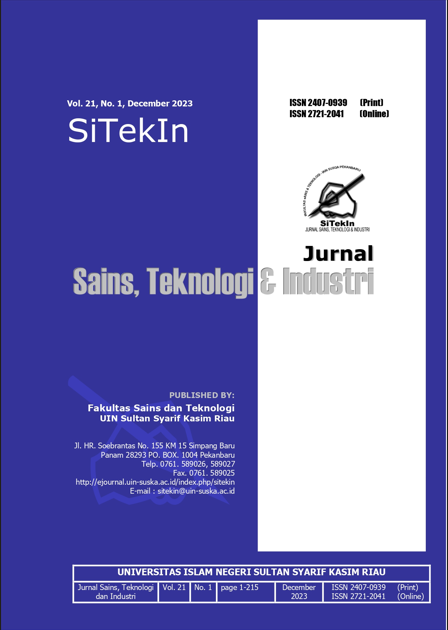Analysis of Palm Biomass Potential for Renewable Energy Sources
DOI:
https://doi.org/10.24014/sitekin.v21i1.27435Abstract
Heaps of palm oil waste resulting from the rapid development of PKS, causing the risk of environmental pollution, decreased productivity and income of the people living in the factory area. in order to achieve the research objective, namely to find out the opportunities for palm biomass as a renewable energy source using the Composite Performance Index method and later be able to make a decision. Based on the implementation of the research conducted, it was found that only one sustainable biomass was palm shell with a value of 437.5, POME, a value of 425.4 fibers, a value of 367.17 and empty fruit bunches with a value of 343.82.
References
M. Najib and D. Satria, “Sistem Pendukung Keputusan Penerimaan Staff Administrasi Menggunakan Metode VIKOR,” vol. 1, no. 1, pp. 39–49, 2023.
A. S. Pramudiyanto, S. Widodo, and A. Suedy, “Energi Bersih dan Ramah Lingkungan dari Biomassa untuk Mengurangi Efek Gas Rumah Kaca dan Perubahan Iklim yang Ekstrim,” vol. 1, no. 3, pp. 86–99, 2020, doi: 10.14710/jebt.2020.9990.
A. Herdiansah, “Sistem Pendukung Keputusan Referensi Pemilihan Tujuan Jurusan Teknik Di Perguruan Tinggi bagi Siswa Kelas XII IPA Mengunakan Metode AHP,” vol. 19, no. 2, pp. 223–234, 2020.
L. Sarumaha, E. Buululu, A. M. H. Sihite, and D. P. Utomo, “Sistem Pendukung Keputusan Penempatan Mentor Pada Pusat Pengembangan Anak IO 558 Sangkakala Medan Menggunakan Metode CPI dan ROC,” vol. 4, pp. 315–321, 2020, doi: 10.30865/komik.v4i1.2713.
M. N. Abbas, I. Colanus, R. Drajana, and A. Bode, “Sistem Pendukung Keputusan Bantuan Rumah Rehab Menggunakan Metode Composite Performance Index,” vol. 5, no. 6, pp. 867–876, 2022.
R. A. S, Y. Arkeman, and E. Hambali, “Indonesia ’ s Oil Palm Bioenergy Sustainability Assessment System using Indonesian Bioenergy Sustainability Indicators ( IBSI ),” no. February, pp. 171–176, 2019.
A. Simangunsong, R. M. Simanjorang, and H. Fahmi, “Penerapan Metode Composite Performance Index Dalam Seleksi Penerimaan Calon Laboran,” vol. 1, pp. 41–47, 2022.
L. Parinduri and T. Parinduri, “Konversi Biomassa Sebagai Sumber Energi Terbarukan,” J. Electr. Technol., vol. 5, no. 2, pp. 88–92, 2020, [Online]. Available: https://www.dosenpendidikan.
N. Nugroho, “Implementasi Metode Composite Performance Index ( CPI ) Pada Sistem Pendukung Keputusan Pemilihan SSD Eksternal,” vol. 4, no. 1, pp. 135–144, 2022, doi: 10.47065/josyc.v4i1.2553.
I. Engineering et al., “MULTIPLE-CRITERIA DECISION ANALYSIS MENGGUNAKAN COMPOSITE,” vol. 7, no. 1, pp. 44–54, 2023.
C. M. A. Wattimena, L. R. Parera, and W. N. Imlabla, “Teknik Budidaya Beberapa Jenis Kayu Penghasil Bioenergi Untuk Menunjang Produktifitas Briket Arang,” vol. 4, no. 1, pp. 39–58, 2021.
D. P. Yuniarti, R. Komala, and S. Aziz, “Pengaruh Proses Aerasi Terhadap Pengolahan Limbah Cair Pabrik Kelapa Sawit Di Ptpn Vii Secara Aerobik,” Tek. Lingkung., vol. 4, no. 2, pp. 7–16, 2019, [Online]. Available: https://doi.org/10.31851/redoks.v4i2.3504
Arsyad, S. Yana, Radhiana, Ulfia, Fitriliana, and Juwita, “Kendala Teknologi, Pendanaan dan Ketersediaan Bahan Baku Biomassa dalam Pengembangan Energi Terbarukan,” J. Serambi Eng., vol. VIII, no. 1, pp. 4940–4946, 2023.
M. Faizah, A. Rizky, A. Zamroni, and U. Khasan, “Pembuatan Briket sebagai Salah Satu Upaya Pemanfaatan Limbah Pertanian Bonggol Jagung di Desa Tampingmojo,” Jumat Pertan. J. Pengabdi. Masy., vol. 3, no. 2, pp. 65–68, 2022, doi: 10.32764/abdimasper.v3i2.2863.
B. Satria, A. Sidauruk, R. Wardhana, A. Al Akbar, and M. A. Ihsan, “Penerapan Composite Performance Index (CPI) Sebagai Metode Pada Sistem Pendukung Keputusan Seleksi Penerima Beasiswa,” Indones. J. Comput. Sci., vol. 11, no. 1, pp. 566–576, 2022.
Downloads
Published
Issue
Section
License
This work is licensed under a Creative Commons Attribution-ShareAlike 4.0 International License
Copyright Notice
An author who publishes in the SITEKIN Journal agrees to the following terms:
- Author retains the copyright and grants the journal the right of first publication of the work simultaneously licensed under the Creative Commons Attribution-ShareAlike 4.0 License that allows others to share the work with an acknowledgement of the work's authorship and initial publication in this journal
- Author is able to enter into separate, additional contractual arrangements for the non-exclusive distribution of the journal's published version of the work (e.g., post it to an institutional repository or publish it in a book) with the acknowledgement of its initial publication in this journal.
- Author is permitted and encouraged to post his/her work online (e.g., in institutional repositories or on their website) prior to and during the submission process, as it can lead to productive exchanges, as well as earlier and greater citation of the published work (See The Effect of Open Access).
Read more about the Creative Commons Attribution-ShareAlike 4.0 Licence here: https://creativecommons.org/licenses/by-sa/4.0/.

